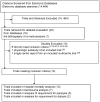Pressure and volume limited ventilation for the ventilatory management of patients with acute lung injury: a systematic review and meta-analysis
- PMID: 21298026
- PMCID: PMC3030554
- DOI: 10.1371/journal.pone.0014623
Pressure and volume limited ventilation for the ventilatory management of patients with acute lung injury: a systematic review and meta-analysis
Abstract
Background: Acute lung injury (ALI) and acute respiratory distress syndrome (ARDS) are life threatening clinical conditions seen in critically ill patients with diverse underlying illnesses. Lung injury may be perpetuated by ventilation strategies that do not limit lung volumes and airway pressures. We conducted a systematic review and meta-analysis of randomized controlled trials (RCTs) comparing pressure and volume-limited (PVL) ventilation strategies with more traditional mechanical ventilation in adults with ALI and ARDS.
Methods and findings: We searched Medline, EMBASE, HEALTHSTAR and CENTRAL, related articles on PubMed™, conference proceedings and bibliographies of identified articles for randomized trials comparing PVL ventilation with traditional approaches to ventilation in critically ill adults with ALI and ARDS. Two reviewers independently selected trials, assessed trial quality, and abstracted data. We identified ten trials (n = 1,749) meeting study inclusion criteria. Tidal volumes achieved in control groups were at the lower end of the traditional range of 10-15 mL/kg. We found a clinically important but borderline statistically significant reduction in hospital mortality with PVL [relative risk (RR) 0.84; 95% CI 0.70, 1.00; p = 0.05]. This reduction in risk was attenuated (RR 0.90; 95% CI 0.74, 1.09, p = 0.27) in a sensitivity analysis which excluded 2 trials that combined PVL with open-lung strategies and stopped early for benefit. We found no effect of PVL on barotrauma; however, use of paralytic agents increased significantly with PVL (RR 1.37; 95% CI, 1.04, 1.82; p = 0.03).
Conclusions: This systematic review suggests that PVL strategies for mechanical ventilation in ALI and ARDS reduce mortality and are associated with increased use of paralytic agents.
Conflict of interest statement
Figures
References
-
- Greenfield LJ, Ebert PA, Benson DW. Effect of positive pressure ventilation on surface tension properties of lung extracts. Anesthesiology. 1964;25:312–16. - PubMed
-
- Webb HH, Tierney DF. Experimental pulmonary edema due to intermittent positive pressure ventilation with high inflation pressures. Protection by positive end-expiratory pressure. Am Rev Respir Dis. 1974;110:556–65. - PubMed
-
- Kolobow T, Moretti MP, Fumagalli R, Mascheroni D, Prato P, et al. Severe impairment in lung function induced by high peak airway pressure during mechanical ventilation. Am Rev Respir Dis. 1987;135:312–15. - PubMed
-
- Meade MO, Cook DJ. The etiology, consequences, and prevention of barotrauma: a critical review of the literature. Clin Intens Care. 1995;6:166–73. - PubMed
-
- Gattinoni L, Pesenti A, Avalli L, Rossi F, Bombino M. Pressure-volume curve of total respiratory system in acute respiratory failure. Computed tomographic scan trial. Am Rev Respir Dis. 1987;136:730–36. - PubMed
Publication types
MeSH terms
Grants and funding
LinkOut - more resources
Full Text Sources
Other Literature Sources
Medical



